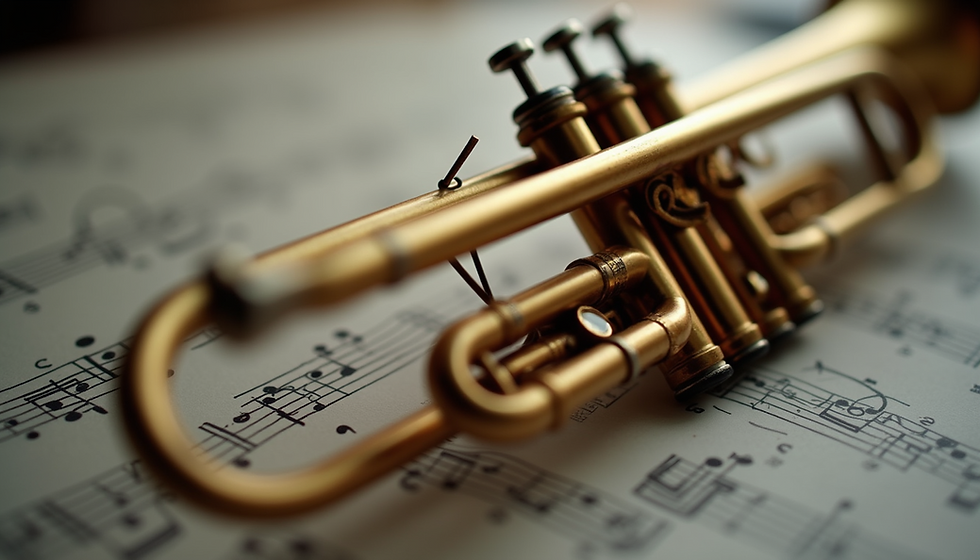How to Craft an Unforgettable Trumpet Solo with Famous Examples and Step-by-Step Guidance
- Nadia Pompilio
- Jul 31
- 4 min read
Updated: Aug 1
Creating a memorable trumpet solo is more than just playing notes; it is about weaving together emotions, technical ability, and creativity. This journey is for everyone, whether you are just starting your musical path or have years of experience. In this post, we will explore the essential elements of an unforgettable trumpet solo, highlight famous examples, and provide clear, actionable steps to guide you in crafting your own masterpiece.
The Essence of an Unforgettable Trumpet Solo
A great trumpet solo can stay with an audience long after the last note fades away. So, what makes a solo truly remarkable? Here are some key components to consider:
Emotional Connection
The ability to connect emotionally with the audience is crucial. A successful solo should spark feelings of joy, sadness, or nostalgia. For instance, the late Louis Armstrong's performances often evoked a deep emotional response due to his expressive tone and phrasing.
Melody and Harmony
A strong melody paired with effective harmony can elevate a solo. Consider how your melody interacts with the chord changes. For example, in the classic "West End Blues," Armstrong creates a melody that is both simple and profound, enhancing the emotional weight of the piece.
Technical Mastery
Technical proficiency cannot be overlooked. It allows a musician to execute complex ideas with ease. This was evident in Dizzy Gillespie's “A Night in Tunisia,” where his precise execution of rapid phrases showcases his mastery and makes the performance unforgettable.
Unique Style
Your personal style makes your solo distinct. Whether it’s a specific way of using rhythm or improvisation, integrating these elements helps create a unique musical fingerprint. For instance, Miles Davis’s minimalist approach in “So What” set his style apart from other jazz musicians of his era.
Famous Trumpet Solos That Inspire
Looking at famous trumpet solos can provide insight into what makes them stand out. Here are some notable examples:
Louis Armstrong’s “West End Blues”
In “West End Blues,” Armstrong's solo is compelling for its emotional depth. His ability to convey feelings of longing and triumph is what makes this performance memorable, demonstrating that emotions can indeed translate into music.
Miles Davis's “So What”
Davis's contribution in "So What" is a masterclass in melody and harmony. This piece from Kind of Blue establishes a modal framework, allowing his unique trumpet lines to shine through with power and simplicity, emphasizing the importance of choosing the right melodic approach.
Dizzy Gillespie’s “A Night in Tunisia”
Gillespie's complex rhythms and vibrant energy characterize “A Night in Tunisia.” His innovative improvisation techniques set new standards in jazz and illustrate how technical skill can truly captivate an audience.
Step-by-Step Guide to Writing Your Own Trumpet Solo
Now that we’ve discussed key elements and examples, let's focus on the process of composing your own trumpet solo.
Step 1: Choose Your Theme or Emotion
Start by deciding what you want to convey. Whether it's happiness or melancholy, selecting a theme gives your melody direction. For example, if you choose a theme of nostalgia, think about how your notes can reflect that feeling.
Step 2: Develop a Melody
Craft a melody that embodies your chosen emotion. Begin with simple phrases, using intervals that resonate. For example, consider starting your melody with a short ascending phrase, followed by a descending conclusion.
Step 3: Create Harmonic Structure
Outline the chords that will support your melody. Many successful solos use progressions like I-IV-V-I. Experiment with variations—changing just one chord can alter the mood significantly.
Step 4: Add Technical Flourishes
Now, add in technical elements that showcase your skills. This could include fast runs or unique articulations. However, make sure these additions serve the melody, rather than overwhelm it. For instance, a well-placed trill can heighten a climactic point.
Step 5: Experiment with Rhythmic Phrasing
Rhythm has a profound impact on your solo's feel. Try incorporating syncopation—or varying the length of notes—to enhance the groove. For example, alternating between staccato and legato notes can create an engaging contrast.
Step 6: Improvise
Once your melody and structure are in place, practice improvisation. It may lead to new ideas that could become key parts of your solo. Allow yourself the freedom to explore different sounds and phrases.
Step 7: Refine and Edit
After creating your initial draft, take time to refine your solo. Look for areas of flow and coherence. It’s helpful to share your work with peers for feedback, as fresh ears can spot things you might not notice.
Step 8: Practice and Perform
Finally, dedicate time to practice your solo. The more familiar you become, the more confident you will feel when performing. Remember, practice is not just about repetition; it’s about integrating your emotional expression with technical skill.

Final Thoughts on Crafting an Unforgettable Solo
Creating an unforgettable trumpet solo requires a balance of emotional expression, technical skill, and individuality. By studying legendary performances and following a structured approach, you can develop solos that resonate deeply with your audience. Embrace your unique voice, and let your passion guide every note you play. Whether you aim to forge a deep emotional connection or showcase your technical prowess, the journey of crafting your solo can be truly rewarding. So pick up your trumpet, allow your creativity to flourish, and compose something truly special.



Comments